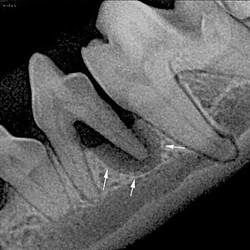
Dentistry
Imagine what your mouth would feel like if you never brushed your teeth or went to the dentist. For many dogs and cats, this is a painful reality. According to the American Veterinary Dental Society, more than 80% of dogs and 70% of cats have dental disease by the age of 3. Dental (or periodontal) disease is the most frequently diagnosed health problem in pets.
Common signs of dental disease include:
Yellow or brown buildup (tartar) on the teeth Loose teeth
Red, Swollen, or bleeding gums Depression
Bad breath Pawing at the face
Excessive drooling
Changes in eating or chewing habits
Even if your dog or cat doesn’t have these symptoms, we recommend that you have a veterinarian evaluate your pet’s dental health at least once a year. Bacteria and food debris accumulate around the teeth and, if left unchecked, will lead to deterioration of the soft tissue and bone surrounding the teeth. This decay can result in irreversible periodontal disease, tooth loss, and possibly expensive oral surgery.
Dental disease can also affect other organs in the body: Bacteria in the mouth can get into the bloodstream and cause serious infections in the kidneys, liver, lungs, and heart. If these problems aren’t caught and treated quickly enough, they can result in death. A physical examination combined with appropriate laboratory work can determine if infection in the mouth has spread.
Schedule your pet’s dental exam today! We can also help show you how to brush your pet’s teeth and recommend foods and treats that will help combat plaque and tartar buildup.
Dental Pricing
All dental procedures include Pre-medications, Gas Anesthesia, Continuous Monitoring, Intravenous Catheter and Fluids, Dental Scaling and Polishing and Dentistry Supplies. The pricing does not include dental extractions, additional anesthesia needed for dental extractions, dental x-rays, antibiotics, pain medications or Elizabethan collars.
Dogs:
Young (under 10 years of age), Healthy (no ongoing medical issues or pet is stable with medical issues), non-brachiocephalic (short muzzle) animals: $305.00
Geriatric (over 10 years of age), brachiocephalic (short muzzle) animals: $340.00
Cats:
Young (under 10 years of age), Healthy (no ongoing medical issues or stabilized medical issues), animals: $280.00
Geriatric (over 10 years of age) animals: $315.00
Possible additional charges could include dental extractions ($5.00 to $125.00 per tooth), additional anesthesia for dental extractions ($30.00 to $45.00 per tooth), bone grafting materials ($20.00 to $40.00), pain medications (cats = $25.00 to $35.00, dogs = $20.00 to $35.00), Elizabethan collars ($8.00 to $22.00), microchipping ($55.64), and nail dremel ($20.00).
Pre-Anesthetic Blood Screening is necessary for all patients and must have been performed within 30 days prior to surgery or can be performed the day of surgery at the cost of $125.00 for patients 1-6 years of age and $175.00 for patients 7 years and older.
Imagine what your mouth would feel like if you never brushed your teeth or went to the dentist. For many dogs and cats, this is a painful reality. According to the American Veterinary Dental Society, more than 80% of dogs and 70% of cats have dental disease by the age of 3. Dental (or periodontal) disease is the most frequently diagnosed health problem in pets.
Common signs of dental disease include:
Yellow or brown buildup (tartar) on the teeth Loose teeth
Red, Swollen, or bleeding gums Depression
Bad breath Pawing at the face
Excessive drooling
Changes in eating or chewing habits
Even if your dog or cat doesn’t have these symptoms, we recommend that you have a veterinarian evaluate your pet’s dental health at least once a year. Bacteria and food debris accumulate around the teeth and, if left unchecked, will lead to deterioration of the soft tissue and bone surrounding the teeth. This decay can result in irreversible periodontal disease, tooth loss, and possibly expensive oral surgery.
Dental disease can also affect other organs in the body: Bacteria in the mouth can get into the bloodstream and cause serious infections in the kidneys, liver, lungs, and heart. If these problems aren’t caught and treated quickly enough, they can result in death. A physical examination combined with appropriate laboratory work can determine if infection in the mouth has spread.
Schedule your pet’s dental exam today! We can also help show you how to brush your pet’s teeth and recommend foods and treats that will help combat plaque and tartar buildup.
Dental Pricing
All dental procedures include Pre-medications, Gas Anesthesia, Continuous Monitoring, Intravenous Catheter and Fluids, Dental Scaling and Polishing and Dentistry Supplies. The pricing does not include dental extractions, additional anesthesia needed for dental extractions, dental x-rays, antibiotics, pain medications or Elizabethan collars.
Dogs:
Young (under 10 years of age), Healthy (no ongoing medical issues or pet is stable with medical issues), non-brachiocephalic (short muzzle) animals: $305.00
Geriatric (over 10 years of age), brachiocephalic (short muzzle) animals: $340.00
Cats:
Young (under 10 years of age), Healthy (no ongoing medical issues or stabilized medical issues), animals: $280.00
Geriatric (over 10 years of age) animals: $315.00
Possible additional charges could include dental extractions ($5.00 to $125.00 per tooth), additional anesthesia for dental extractions ($30.00 to $45.00 per tooth), bone grafting materials ($20.00 to $40.00), pain medications (cats = $25.00 to $35.00, dogs = $20.00 to $35.00), Elizabethan collars ($8.00 to $22.00), microchipping ($55.64), and nail dremel ($20.00).
Pre-Anesthetic Blood Screening is necessary for all patients and must have been performed within 30 days prior to surgery or can be performed the day of surgery at the cost of $125.00 for patients 1-6 years of age and $175.00 for patients 7 years and older.

Dental X-Ray
Dental X-ray is an amazing tool that we use to give us a more complete picture of your pet’s dental health, which in turn affects your pet’s overall health and lifespan. As you can see from the pictures above, there are many times when a tooth will appear perfectly normal upon oral examination. Since 60% of the tooth is below the gum line, a regular oral examination only reveals part of the story.
The two sets of pictures in the middle and on the right above show teeth that are not chipped, discolored or in any way showing signs of disease. In the middle pictures, the circled teeth have died (indicated by the widened pulp canals that the arrows are showing) and are beginning to cause abscesses. In the picture on the right above, the tooth again, is perfect above the gum line. The x-ray shows that there is a very large abscess and bone loss greater than 50% below the gum tissue.
The set of pictures on the left reveal an area of questionable tissue just in front of the large canine tooth. X-ray shows that there is a problem there in addition to decay that has also destroyed three small incisors. This cat will need to have 4 teeth removed; 3 simple extractions and 1 surgical extraction.
Conversely, there are many times that a patient will come in with excessive amounts of tartar build-up, chipped and or discolored teeth which leads the doctor to believe the teeth should be extracted. Dental x-ray in these cases can tell us that even though the teeth above the gum appear damaged, there is less than 50% bone loss and they should not be extracted at this time, but should be monitored for changes in the future.
We are proud to offer digital dental x-ray and give our clients the option to have full-mouth dental x-rays at a discounted price. Patients have their dental health monitored as part of our wellness program and the doctor will make recommendations regarding dental care or dental home care to help you provide the longest, healthiest life possible for your pet.
Dental X-ray is an amazing tool that we use to give us a more complete picture of your pet’s dental health, which in turn affects your pet’s overall health and lifespan. As you can see from the pictures above, there are many times when a tooth will appear perfectly normal upon oral examination. Since 60% of the tooth is below the gum line, a regular oral examination only reveals part of the story.
The two sets of pictures in the middle and on the right above show teeth that are not chipped, discolored or in any way showing signs of disease. In the middle pictures, the circled teeth have died (indicated by the widened pulp canals that the arrows are showing) and are beginning to cause abscesses. In the picture on the right above, the tooth again, is perfect above the gum line. The x-ray shows that there is a very large abscess and bone loss greater than 50% below the gum tissue.
The set of pictures on the left reveal an area of questionable tissue just in front of the large canine tooth. X-ray shows that there is a problem there in addition to decay that has also destroyed three small incisors. This cat will need to have 4 teeth removed; 3 simple extractions and 1 surgical extraction.
Conversely, there are many times that a patient will come in with excessive amounts of tartar build-up, chipped and or discolored teeth which leads the doctor to believe the teeth should be extracted. Dental x-ray in these cases can tell us that even though the teeth above the gum appear damaged, there is less than 50% bone loss and they should not be extracted at this time, but should be monitored for changes in the future.
We are proud to offer digital dental x-ray and give our clients the option to have full-mouth dental x-rays at a discounted price. Patients have their dental health monitored as part of our wellness program and the doctor will make recommendations regarding dental care or dental home care to help you provide the longest, healthiest life possible for your pet.